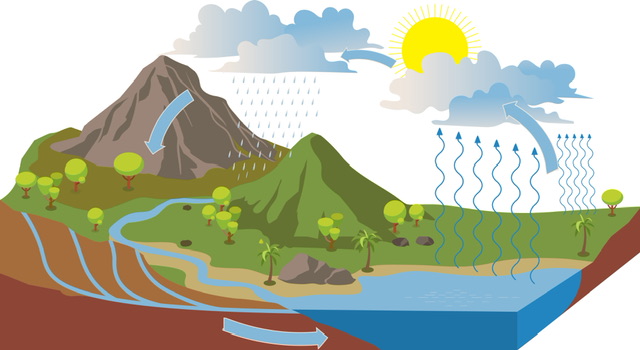We'll be back in a bit !
The system is currently undergoing a routine upgrade to ensure you get the best learning experience. The maintenance is expected to continue till 8:00 pm. Please check back later.
Thank you for your understanding!

Introduction
Life is heavily dependent on water and we won’t be able to survive without water even for a few days. The presence of water also makes the climate and other factors on Earth capable of sustaining life. Over 70% of this planet is covered in water.
The water cycle is a term that refers to the various processes that take place and are responsible for the constant movement of water across the planet in different forms. Land water evaporates and creates vapor. This vapor rises up and then falls as rain or snow.
While the total amount of water on this planet has not changed since it first appeared, water constantly changes form and travels across Earth. This is known as the water cycle and consists of the following processes:
Evaporation
Transpiration
Condensation
Precipitation
Run-off/Groundwater collection.
The water cycle naturally recycles water and spreads it across the farthest reaches of Earth. The water cycle is also responsible for keeping our climate life-sustaining and balanced.
The various steps involved in the water cycle are described below:
Evaporation: Evaporation refers to the conversion of liquid into water vapor. Evaporation occurs when the molecules of the water have gained enough energy to get separated from liquid phase water and take a gaseous form. This energy is obtained from the sun, whose rays heat water present on the surface of Earth. Evaporation and its rate are affected by meteorological factors like wind, humidity, etc.
Transpiration: This is a method of water transport that is exclusive to plants. The water that planets obtain from the soil traverses their stems and leaves and is then exchanged with the gasses present in the air. This allows water to escape into the atmosphere.
Sublimation: Sublimation is generally not evident with water. It refers to the conversion of the solid state of a substance directly into the gaseous state without going through the liquid phase.
Condensation: The conversion of the gaseous state of a substance into a liquid state is known as condensation. Condensation occurs when the water content in the atmosphere becomes very high and thus, needs to be released to maintain balance. Water vapor condenses into tiny drops that surround dust and pollutants present in the air.
Precipitation: After condensation, water droplets can fall to Earth in the form of rainfall or snowfall. This process is known as precipitation. This is immensely important for crops and farming.
Runoff: After rainfall, water can flow on the ground towards low-lying areas, which is known as runoff. This returns water to rivers, tributaries, and ponds, thus finishing the cycle right back to where it started.
Infiltration: Water that collects on the ground can get absorbed by the soil, which is known as infiltration. This replenishes groundwater reserves and since the soil acts as a filter, creates underwater reserves suitable for drinking.
Hence, the amount of water on this Earth remains conserved as a whole and only goes through a cycle repeatedly.
Climate refers to the general trend of weather conditions for a location over a long enough period. It is a combination of various factors like humidity, temperature, rainfall, etc., and these factors are heavily affected by the water cycle. Without a water cycle, there would be no rainfall and water would remain stagnated in one place. Further, humidity is related to the amount of water vapor in the atmosphere.
Areas which lie close to the coast are more humid and thus, have a hotter climate. On the other hand, inland areas have lower humidity and drier climate. The water cycle also affects the temperature of an area and generally, rainfall can lead to reduced temperatures.
Water is the most essential natural resource that is necessary for the existence of life on any planet. Its presence and transport on the planet are regulated by a series of processes that give rise to the water cycle. These processes include evaporation, transpiration, sublimation, condensation, run-off, and infiltration.
The water cycle keeps our climate and atmosphere stable and allows for the continued existence of life on Earth. Fluctuations in the water cycle manifest themselves as changes in the climate of a region and if not regulated correctly, the climate of a portion can change drastically.
1. Chemically describe water
Chemically, water is a tasteless, odorless, and colorless compound that is formed by the bonding of two hydrogen atoms to one oxygen atom. Its chemical formula is H2O, and at room temperature, it exists in liquid form. Its freezing and boiling points are 0 0C and 100 0C, respectively.
2. What are water residence times?
Residence time is defined as the amount of water present in a reservoir, divided by the rate water is added to it or lost from it. Thus, for oceans, residence times are of the order of 3000 to 3230 years and for the atmosphere, it is only about 10 days. For other areas like lakes and rivers, residence times lie somewhere in between.
3. What is evapotranspiration?
Evapotranspiration is a term that refers to the combination of evaporation and transpiration.
4. What is Rainwater harvesting?
A large amount of rainwater can get wasted if it is drained across roads or sewers and stagnant water can give rise to mosquitoes and diseases. Instead, we can collect rainwater in specialized tanks and closed containers, which reduces water wastage and can even be used to recharge groundwater. This is known as rainwater harvesting.
